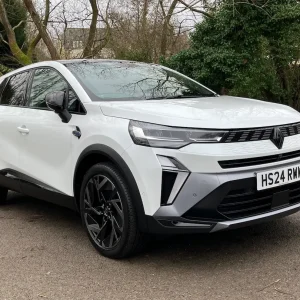Volvo has had a busy year.
On top of its refreshed 90 and 60 series SUV models, the manufacturer has now completed its SUV line-up with the launch of its very first ‘baby’ SUV, the XC40.
The premium SUV is the first of the company’s cars to be based on its CMA small-car architecture and is expected to top all Volvo vehicles in terms of sales, accounting for a predicted 40%, while rivalling popular and established SUVs like the BMW X1 and Audi Q3.
No pressure then.
Stylish design
The manufacturer expects the Momentum to be the best-selling option for a fleet audience, so that’s the one we spent the most time in on the streets of Barcelona.
Although entry-level, the trim is highly specced as standard. In fact, there is a huge selection of standard specifications that would otherwise feature as options on competitors.
Standard equipment includes: a 360-degree surround-view camera; self-parking system; hands-free powered tailgate; panoramic sunroof; wireless phone charging; heated rear seats; a 9in touchscreen system; sat-nav; two-zone climate control with ‘CleanZone’ air-quality system; LED headlights, and 18in alloy wheels.
As you’d expect from a Volvo, the XC40 is full of safety technology. Volvo’s City Safety system, which includes pedestrian, cyclist and large-animal detection, is fitted as standard to every model and will automatically apply the brakes in an emergency if you fail to react in time.
Upgrade to the R-Design trim and the XC40 gains leather upholstery, a gloss-black exterior trim, a sporty body kit, sports suspension and electric folding door mirrors.
Volvo says it will also introduce a range-topping luxurious Inscription model at a later date that will feature driftwood interior touches, as well as ambient interior lighting, a powered tailgate and front parking sensors. Pro level trims, as seen in the 60 and 90 models, are also planned.
Making storage cool again
Volvo has filled the XC40 with neat little touches that you may not notice straight away. There is a cute little rubber Swedish flag hanging off the side of the bonnet and Volvo decided to move the speakers from the doors up to the dash to create even more storage for drivers and passengers, one of those things that appears so simple you wonder why nobody has done it before.
Materials on this trim are of a good quality, but in an effort to cut cost in a less obvious way, Volvo has decided to instead be a little bit creative; our test car featured a bright orange carpet for example. Five stars for effort, Volvo.
However, undoubtedly the best thing about this car is the amount of innovative storage that it is fitted with. There is a removable bin in the centre console, the door pockets are absolutely huge, and there are plenty of hooks dotted around the car to hang vital things such as takeaways. There are even credit card holders on both sides of the steering wheel.
Sitting inside, I felt almost like a kid again, pressing buttons and pushing and pulling things to see what cubbyhole or secret compartment might appear next.
Spacious cabin
The XC40 is one of the largest cars in the compact SUV class with a length of 4,425mm and height of 1,658mm, but unfortunately its luggage capacity doesn’t quite make the grade compared with its competitors. The car has 460 litres with the rear seats up, expanding to 1,336 litres with them folded down; however, the X1 and E-Pace are far bigger. The X1 offers 505 litres, expanding to 1,550-litres, while the latter has 577litres or 1,234 litres.
Available with a range of petrol and diesel engines, paired with either manual or an eight-speed automatic gearbox and front- or all-wheel drive, all the engines are Volvo’s own 2.0-litre Drive-E units, with power outputs ranging from 150hp to 247hp. We drove the D4 engine mated with the auto transmission, which offered 190hp, more than enough power for city and motorway driving. The drive was smooth and wind noise on the motorway was hardly noticeable. Steering was a little on the light side but not unresponsive, and the transmission was smooth and changed gears with ease.
The P11D of £36,950 for this car puts it up there with the more expensive models of its kind – the comparable E-Pace costs £36,895 and the X1 £34,295. But luckily, Volvo’s residual values (RVs) have been getting stronger and stronger with every vehicle it launches. The manufacturer says the XC40 is one of the best in its class in this respect. The X1, for example, has an RV of 40.9%, while the XC40 reaches 44.2%.
KeeResources tells us that the car has CO2 figures of 133g/km compared to the equivalent X1’s 114g/km. However, it is lower than the E-Pace, at 147g/km. The MPG comes out lower than the X1 at 55.4mpg compared to its 65.7mpg, but the E-Pace loses here at 50.4mpg.
The cost per mile is quite high at 73.1p compared with 68.1p for the X1. It beats the E-Pace, though, which costs 75.2p.
Volvo has high hopes for its new baby SUV, and our first drive left us impressed. With ample storage, impressive RVs and a great standard spec on all models, the XC40 might just be the model the segment has been waiting for.
Volvo XC40 D4 2.0-litre Momentum
P11D Price: £36,950
On sale: March 2018
Residual value: 44.2%
Depreciation: £20625
Fuel: £5819
Service, maintenance & repair: £2587
Cost-per-mile: 73.1p
Fuel consumption: 55.4mpg
CO2 (BIK Band): 133g/km (28%)
BIK 20/40% per month: £172/414
Boot space: 460/1,336litres
Engine size/power: 1969cc/190hp





